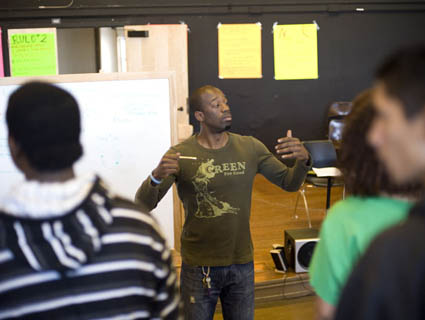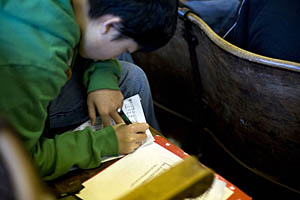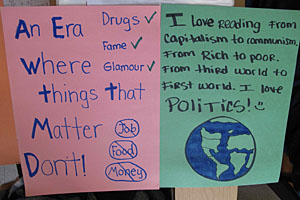 Illustration by Jon Krause“SPEEK EENGLISH, TACO,” THE GIRL with the giant backpack yelled when Maria asked where to find a bathroom. The backpack giggled as it bounced down the hall. It had been hours since Maria began looking for a bathroom. Anger boiled inside her, but she didn’t know any English words to yell back. That was the hardest part. Back in El Salvador she’d always had something to say.
Illustration by Jon Krause“SPEEK EENGLISH, TACO,” THE GIRL with the giant backpack yelled when Maria asked where to find a bathroom. The backpack giggled as it bounced down the hall. It had been hours since Maria began looking for a bathroom. Anger boiled inside her, but she didn’t know any English words to yell back. That was the hardest part. Back in El Salvador she’d always had something to say.
The bell rang. A flood of shoulders and sneakers swirled around Maria, and she couldn’t see much until the sea of strangers streamed back into classrooms. Then she stood alone in the hallway.
It was Maria’s first day at school, her first week in the United States. Her middle school in San Francisco was the biggest building she’d ever seen. It was bigger than the entire Best Buy store she’d walked through in awe on her first day in the city.
Eventually, Maria found her way to class, a special setting for Spanish-speaking newcomers. There she would practice English words for colors and numbers, learn how to introduce herself and how to say thank you. By eighth grade she was moved into mainstream classes, where she struggled. It didn’t help that her math teacher started each class by saying, “Okay, my little dummies.” He spoke really fast. Maria never raised her hand in his class.
One day Maria stopped by the administrative office, looking for someone to help her with multiplication. She took her spot in line behind a middle-aged woman who chatted with her in Spanish as they waited. Maria said school was really hard for her. The woman told her not to worry. “Latinas usually don’t finish high school,” she said. “They go to work or raise kids.”
The woman was right, statistically speaking, and Maria’s middle-school experience all but ensured she’d join the 52 percent of foreign-born Latinos who drop out of high school. She graduated from eighth grade without learning to speak English. She had a hard time writing in Spanish and didn’t know how to multiply.
And then everything changed. At Mission High, the struggling school she’d chosen against the advice of her friends and relatives, Maria earned high grades in math and some days caught herself speaking English even with her Spanish-speaking teachers. By 11th grade, she wrote long papers on complex topics like desegregation and the war in Iraq. She became addicted to winning debates in class, despite her shyness and heavy accent. In her junior year, she became the go-to translator and advocate for her mother, her aunts, and for other Latino kids at school. In March, Maria and her teachers were celebrating acceptance letters to five colleges and two prestigious scholarships, including one from Dave Eggers’ writing center, 826 Valencia.
But on the big state tests—the days-long multiple-choice exams that students in California take once a year—Maria scored poorly. And these standardized tests, she understood, were how her school was graded. According to the scores, Mission High is among the lowest-performing 5 percent of schools in the country, and it has consistently failed to meet the ever-rising benchmarks set by the federal No Child Left Behind Act. The law mandates universal “proficiency” in math and reading by 2014—a deadline that weighs heavily on educators around the nation, since schools that don’t meet it face stiff penalties.
IT WAS WITH THESE PENALTIES on his mind that Mission High principal Eric Guthertz got ready for work one morning in 2010. It was his wife’s birthday, and also the day California was supposed to release its list of “persistently low-performing” schools—schools that the state deemed as urgently in need of improvement. As he put on his tie, he recalls, “I told my wife, ‘I hope we dodged that bullet!’ But I was kidding, because I was convinced we wouldn’t be on that list. And on my ride to school, I was feeling bad for the principals” who would.
It wasn’t long after he got to the office that the phone rang. It was the district. Mission was on the list.
Guthertz was in shock. His teachers had been working so hard, he thought. What would they say? How about the parents, the students? Where would he get extra resources to bring up the numbers? Mission’s test scores and college acceptance rates had been going up. But for purposes of the list, that didn’t matter.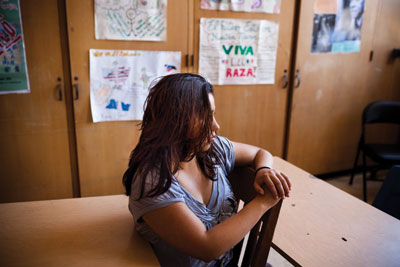 Maria arrived at Mission barely speaking English. By the time she left she’d been admitted to five colleges. Photo by Lianne Milton
Maria arrived at Mission barely speaking English. By the time she left she’d been admitted to five colleges. Photo by Lianne Milton
A few months later, Guthertz got another call from the district. This one was of the good news/bad news variety: As a low-performing school, Mission qualified for additional funding—but only if it agreed to undergo a major restructuring. Options included replacing the principal and either revamping the curriculum or replacing half the staff; closing the school; or turning it into a charter. Guthertz had been promoted to his job less than two years earlier, and the district was allowed to report this change to the federal government as a replacement of the principal—a loophole that bought Mission some time. But San Francisco’s oldest comprehensive public high school, founded in 1890, would still have to show dramatic growth in scores by 2014 or face more interventions, including possible closure.
Around the same time that Guthertz was digesting this news, I was calling education officials in search of a school that would let me spend time inside its classrooms. I was looking for a grassroots view of America’s latest run at school reform: How do we know when schools are failing, and why is it so hard to turn them around? Is the close to $4.4 billion spent on testing since 2002—with scores now used for everything from deciding teacher pay to allocating education budgets—getting results? Is all that data helping us figure out what really works, or seducing us into focusing only on what the tests can measure?
If you wonder why you haven’t read many accounts of how these questions are playing out in real life, there’s a reason: It’s easier for a journalist to embed with the Army or the Marines than to go behind the scenes at a public school. It took months to find one that would let me play fly on the wall. Once Guthertz opened the door at Mission, it took months more for some teachers, wary of distortion and stereotyping, to warm to me. In the end, I’d spend more than 18 months in Mission’s classrooms, cafeterias, and administrative offices, finally watching the Class of 2012—including a beaming Maria—show off their diplomas.
The surprises began almost right away. Judging from what I’d read about “troubled” schools, I’d expected noisy classrooms, hallway fights, and disgruntled staff. Instead I found a welcoming place that many students and staff called “family.” After a few weeks of talking to students, I failed to find a single one who didn’t like the school, and most of the parents I met were happy too. Mission’s student and parent satisfaction surveys rank among the highest in San Francisco.
One of the most diverse high schools in the country, Mission has 925 students holding 47 different passports. The majority are Latino, African American, and Asian American, and 72 percent are poor. Yet even as the school was being placed on the list of lowest-performing schools, 84 percent of the graduating class went on to college, higher than the district average; this year, 88 percent were accepted. (Nationally, 32 percent of Latino and 38 percent of African American students go to college.) That same year, Mission improved Latinos’ test scores more than any other school in the district. And while suspensions are skyrocketing across the nation, they had gone down by 42 percent at Mission. Guthertz had seen dropout rates fall from 32 percent to 8 percent. Was this what a failing school looked like?
WHEN MARIA TURNED THREE, SHE stopped hearing the voice of her mother in the mornings. No one explained where she’d gone, but when Maria was seven, her grandmother explained that her mom had crossed three borders to find work in California. Maria and her older brother were raised by her grandparents in the village of San Juan Las Minas in El Salvador. Their aunt Angelica came to visit when she could.
Maria doesn’t remember much from those days except for her auntie’s soft, soothing voice. Angelica had two children of her own, but she didn’t mind when Maria started calling her “mom.” When Angelica left, Maria kept to herself. Her grandparents were busy growing vegetables, raising cows and chickens, and looking after Maria, her brother, and four cousins.
Angelica ran a corner liquor store in San Salvador, two hours away. To stay in business, she had to pay off the MS-13 gang each month. They left her alone most of the time, except the day they shot one of her customers in the store. Maria was there. A piece of the man’s head dropped on her foot.
Angelica loved escaping the city for Las Minas. “I’m like you, Maria. Like a little girl,” she used to say when they played soccer together or climbed the mango trees.
Maria remembers everything about the day of her auntie’s funeral. Angelica’s tall body in a light wooden coffin beside the kitchen table, surrounded by candles. The scent of wax giving way to the smell of beer and sticky sweat as the day wore on. The 20 strangers in the house, their shiny, shirtless bodies covered in tattoos of letters, numbers, and devil’s horns: symbols for MS-13. As the house got hotter, the men’s voices grew louder. They started playing poker, roaring at their own jokes.
Maria, now 12, was praying near the coffin. She could see her auntie’s dark hair through the white lace covering her face. It had been a week since she’d last heard from her. “Don’t worry,” Angelica had said. “I’ll take care of everything. I’ll pay off MS-13.”
Making the Grade
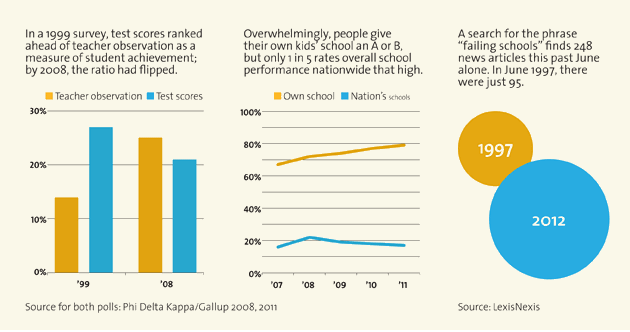
But she couldn’t. She didn’t have enough money. Three days after that call, she was found at the entrance of a San Salvador hospital, naked and barely alive. The doctors said she’d been raped and tortured for days. There was nothing they could do to save her.
Maria tried to focus on praying, but the men who’d invaded her grandparents’ house got louder, throwing cards across the table and spitting on the floors. Maria gathered her courage and walked toward them. “Be respectful or get out of my house!” she shouted. The men’s heads turned. For a few moments, the house was quiet. Then the men started laughing.
They left only after Angelica was buried, and they’d taken all of Maria’s grandparents’ money.
“Why don’t you come to America?” Maria’s mother asked her on the phone a week after the funeral. She had been talking to her about coming to the States since she was seven. “I’d always say no,” Maria recalls. “I loved my auntie more than anything. I didn’t want to be in any other country but mine. But when my auntie died, I had no one close left.”
Maria was the youngest passenger on the bus crossing El Salvador, Guatemala, and Mexico toward California. Her mom had paid the coyote $3,000, and Maria’s ride was easy. No wandering through the desert. The coyote bought them chicken for dinner every night. At home, her grandparents cooked chicken only when relatives came over on Sunday.
THE FIRST TIME MARIA SET FOOT IN Mission High, she thought it looked like a church. The facade and doorway were decorated with intricate Spanish Baroque moldings. Heavy iron chandeliers adorned the ornate ceiling above the entrance hall. The light glittered on spotless yellow linoleum. As Maria and her middle-school classmates toured the library, courtyards, and cafeteria, she noticed that people seemed friendly. Even the security guards were cracking jokes. Principal Guthertz regaled students with the school’s history and famous alumni: Carlos Santana, Maya Angelou. There were after-school programs—the Latino student club, soccer, creative writing. Maria asked a few students if they liked Mission. To her surprise, all of them did.
Everyone Maria knew outside of Mission told her not to go there. Her mother’s friends said she should pick a better school. Maria’s friends said Mission had gangs.
Guthertz introduced Maria to Amadis Velez, who spoke to her in Spanish. He told her that he’d be her English teacher. On the wall, Maria noticed Velez’s diploma from the University of California-Berkeley, surrounded by photos of Frida Kahlo, César Chávez, and Salvador Dalí. “He was so welcoming,” Maria remembers. “He kept making jokes about our English, making us laugh. After I met Mr. Velez, I knew I’ll be going to Mission.”
“She didn’t speak a lick of English when she started in my ninth-grade English class,” Velez recalls. “That year, there were only two students whose English was worse than Maria’s.” Velez also noticed that Maria’s Spanish grammar was about two years behind her Latino classmates’. Maria was 5 feet tall and weighed about 80 pounds. “She was tiny,” Velez remembers, “but very spunky, and her leadership and popularity among students stood out to me right away.”
Maria loved that she had a class with Velez every day. He taught her English and geography in the 9th grade, and history in the 10th. He often checked in with her in the afternoon. All kinds of worries kept pouring out in their conversations. Could Velez explain the word tariffs? What’s this thing, analysis? Who could teach Maria how to multiply?
“I thought of myself as a really bad student back then,” she recalls. “I didn’t believe in myself. But Mr. Velez always told me not to give up, to keep going, keep pushing.”
One day, Velez sat her down, took out a piece of paper, and started charting her path to college. He said that she needed to transfer into regular English classes as soon as possible to prepare for college. He also explained that California was one of 12 states that allow undocumented students like her to pay resident tuition rather than out-of-state rates, which can be twice as much. Velez said that Maria was not eligible for any government grants or student loans, but there were private scholarships, and he’d help her get them. All of this was possible, he said, if Maria kept her grades up, did all of her homework, and worked twice as hard as her classmates who already knew English. He said he’d be there for her no matter what. He told her to have fun and to laugh a lot.
Most days Maria did well and felt good about her progress. She met with Velez after class to review her grammar and plan for college. He urged her to write more complex sentences. By the end of 10th grade, she was writing essays that didn’t fit on one page. She earned an A in Mr. Velez’s modern world history class. Maria’s history teacher, Robert Roth, at a picnic celebrating Mission’s gain in test scores. Photo by Winni Wintermeyer
Maria’s history teacher, Robert Roth, at a picnic celebrating Mission’s gain in test scores. Photo by Winni Wintermeyer
Then one morning, over breakfast, she found an envelope on her mother’s kitchen table. Inside were the results of the standardized tests she’d taken a few months before. Her stomach tilted. She’d done much worse than she’d anticipated. In history her score was “far below basic,” the lowest ranking.
What Maria didn’t know was that only 19 percent of Mission High’s Latino students scored “proficient or above” in history. The vast majority of Latinos, at Mission High and statewide, scored similar to Maria.
She knew that Velez thought she was smart. But this was the first grade she’d gotten from people outside of Mission, and it made her wonder. Was Mr. Velez wrong?
EVERY SPRING ACROSS THE NATION, students in 3rd to 11th grade sit down to take standardized tests required by the federal No Child Left Behind Act (NCLB). Each state comes up with its own tests, based on its own list of curriculum standards students have to master in each grade. In most states, standardized tests consist primarily of multiple-choice questions.
People who fought for these tests wanted to raise expectations for all students. They knew that for decades students of color, the learning disabled, and poor students weren’t challenged, often stuck in segregated and underfunded schools and shuffled into vocational training. Education historian Larry Cuban pins the beginning of the move toward high-stakes testing to the passage of the Elementary and Secondary Education Act of 1965, which sent significant extra funding to low-income schools neglected by local school boards.
The policies were also designed to find out which reforms were improving achievement. “Class size reduction, whole language instruction, everything under the sun has been tried in our schools,” Arun Ramanathan, the executive director of the Oakland think tank Education Trust-West, told me. “But how could we assess if there are any returns without reliable data? How could we know what we can scale up?”
As more states started using standardized testing, urban education reformers in the ’70s and ’80s were able to flag the outliers: schools that were reducing the achievement gap between white, middle-class students and students of color and the poor. Cuban believes that this data helped to dismantle the idea that poor, minority, immigrant, or disabled students couldn’t learn.
By 2001, when the Bush administration was pushing No Child Left Behind through Congress, testing had undergone a political transformation: Now it was at the core of a business-inspired approach championed by a loose coalition of corporate leaders like Bill Gates, idealists like Wendy Kopp of Teach for America, and maverick education officials like Washington, DC, schools chief Michelle Rhee, the heroine of the documentary Waiting for “Superman.” Standardized tests, many of these reformers believed, could bring hard-and-fast metrics—and hardcore sanctions—to a complacent world of bureaucrats and teachers’ unions. Closures or mass firings at low-performing schools, bonuses for high-scoring teachers, and an expansion of charter schools were supposed to disrupt a system that, in the reformers’ view, had failed students and the companies for which they would one day work.
No Child Left Behind was animated by this faith in metrics. It mandated that states use test scores to determine whether schools were succeeding or failing, with the latter required to improve or accept punitive measures. NCLB passed with bipartisan support, and many civil rights groups were behind it.
Ten years later, a growing number of education advocates say they didn’t anticipate how high-stakes testing would change instruction for the worse. Among the converts is education historian Diane Ravitch, who served as assistant secretary of education in George H.W. Bush’s administration and was an ardent champion of NCLB. “Accountability turned into a nightmare for American schools,” she wrote in a 2010 Wall Street Journal op-ed, “producing graduates who were drilled regularly on the basic skills but were often ignorant about almost everything else… This was not my vision of good education.” In his studies, Cuban has also found that an increasing proportion of lesson time is spent preparing students for tests, and the curriculum is being narrowed to what is on those tests—even though many researchers agree that cramming for multiple-choice, a.k.a. “bubble,” tests contributes very little to actual learning.
The overwhelming emphasis on testing has led some schools and districts to cheat. An investigation by the state of Georgia last year found widespread test-tampering in Atlanta, and the Atlanta Journal-Constitution has identified similar patterns in hundreds of districts nationwide. Some schools have also cranked up discipline and school-based arrests, leading struggling students to drop out—and thus improving scores.
Overall, the last 10 years have revealed that while Big Data can make our questions more sophisticated, it doesn’t necessarily lead to Big Answers. The push to improve scores has left behind traditional assessments that, research indicates, work better to gauge performance: classroom work and homework, teachers’ grades and quizzes, the opinions of students and parents about a school. In his recent book The Social Animal, conservative columnist and veteran education commentator David Brooks identifies this bias—to emphasize and reward what we can measure, and ignore the rest—as a key reason why technocratic promises in social policy have largely failed to materialize. Research, Brooks notes, shows that the key to success is more often found in realms that resist quantification—relationships, emotions, and social norms.
Even the godfather of standardized testing, the cognitive psychologist Robert Glaser, warned in 1987 about the dangers of placing too much emphasis on test scores. He called them “fallible and partial indicators of academic achievement” and warned that standardized tests would find it “extremely difficult to assess” the key skills people should gain from a good education: “resilience and courage in the face of stress, a sense of craft in our work, a commitment to justice and caring in our social relationships, a dedication to advancing the public good.”
IT WAS EIGHT IN THE MORNING, AND the lights were off in Mr. Roth’s history class as winter rain tapped on the windowsills and warm moisture filled the room. In the flickering light of a television screen, Maria could see her friend Brianna breaking small pieces from a muffin and dropping them into her mouth. Maria lowered her chin into her hands. Her right leg, sheathed in dark blue jeans, bounced on the linoleum floor.
On the TV, Paula Crisostomo was waving a protest sign in the face of a police officer and arguing with her father, a Filipino immigrant wearing a blue work shirt. “I told you to stay away from these agitators!” he yelled at Paula. Based on a true story, Walkout captures the 1968 school protests in East Los Angeles. About 22,000 Latino students participated, inspired by a teacher named Sal Castro. (One of them—Antonio Villaraigosa, né Antonio Villar—is now mayor of LA.) Back then, most Latinos were forbidden from speaking Spanish in class. Curricula largely ignored Mexican American history, and Latinos were steered toward menial labor.
In the film, students could be seen shaking the metal gate of their school, locked shut by officials to prevent them from walking out. The students rattled the bars chanting “Viva la Raza!” while police stood on the other side. The gate broke. Maria’s entire class erupted in applause as the teens flooded into the street.
After the film ended, Robert Roth switched on the lights and turned to a class sitting in motionless silence. “Any thoughts, anyone?”
“It’s incredible to see how courageous Paula was,” said a student from Nicaragua named Catharine. “She lost confidence so many times, but whenever she lost it, her friends were there to support her.”
“In middle school I was told to speak only English at home,” Maria said next. “I think that’s wrong. I already do at school. They shouldn’t tell me how to live my life.”
“I can relate to Paula, how people don’t believe Latinos are smart enough for college,” Yessenia added. “These stereotypes make me want to prove them wrong.”
“Speaking of stereotypes,” Brianna said, “I was in the bathroom with five other black girls, and we were fixing our hair. Two Asian American girls come in and they run out right away, thinking that we are going to bully them. I want to fix that. I’m a nice person!”
Roth jumped in, “Rebecca, you were talking to me about this kind of stereotype the other day. Do you mind sharing what you said?”
“When we moved to St. Louis from China,” Rebecca said, “we went to an all African American school. My parents were telling me to stay away from black students. They said don’t trust them, run away. But they were all really nice to us. A lot of times it’s coming from parents, but they just don’t know.”
At the end of class, Brianna and her friend Destiny came up to Maria. “What’s ‘Viva la Raza’?”
“It kind of means being proud to be Latino,” Maria explained.
“How do you say it?” Brianna asked, and Maria told them. “Viva la Raza! Viva la Raza! Viva la Raza!” the three chanted out loud, fists in the air, laughing.
As students shuffled out, Roth reminded them, “A short reflection on this film is due next time. And please! Don’t summarize, analyze. Why is this important? How does it connect to other things we learned?”
The following Monday, Roth passed back his students’ homework essays. On Maria’s he’d written, “It’s a B this time! See me about this, OK?”
Maria showed up at his office the next day. “Some of the stuff you’ve been writing is so powerful. You are really getting there, Maria,” Roth said, lowering his reading glasses and putting down a folder.
“Why isn’t it an A then?” Maria half-smiled, and pulled out her homework. “Is it because of bad grammar?” She pointed at Roth’s corrections on her paper.
“Look, writing is primarily about ideas,” Roth told her. “Language, grammar, and style are important tools to express those ideas. But don’t start by focusing on a few grammar mistakes, or you’ll get stuck and ignore the bigger issues.” He explained why he made certain corrections, but he spent most of the time talking to Maria about the elements he deems essential “to getting your thoughts out”: thesis, evidence, analysis, and conclusion. “Did you organize your thoughts in a way that made sense?” he asked her. “Did you back up your opinions with evidence? Did you go deep enough?”
Roth explained to Maria that she’d summarized and discussed Walkout really well, but when it came to analysis and conclusion, her writing seemed rushed. “What are the connections between these protests and the African American struggle for civil rights?” Maria gave a few examples. Roth suggested that she think more about why these efforts were successful. “How did these walkouts change things? Why are we studying this?” Photo by Lianne Milton
Photo by Lianne Milton
A few weeks later, Maria presented a research paper on equal access to education. While rewriting her essay about Walkout, she’d discovered that some Latino parents were organizing school boycotts even before the onset of the civil rights movement. “Did you know that Mendez v. Westminster happened eight years before Brown v. Board?” Maria announced to her class. In the 1946 case, Latino parents won the first-ever anti-segregation lawsuit in federal courts. “It helped the Brown v. Board attorneys to win their arguments before the Supreme Court,” she explained. “The Mendez case was the beginning of the end for Plessy v. Ferguson, which said that ‘separate but equal’ is fine.”
“LISTEN! ONE MORE DAY BEFORE THE big bad test,” Roth announced one spring day as he passed out a test that included some practice questions from the California STAR test—the final exam in US history as far as the state was concerned.
Maria and her classmates had been working with their teachers for a month to prepare for the state exams. Principal Guthertz, who has been known to eat live worms in front of students as a reward for higher test scores, promised to get a famous chef to cook a free meal for the entire school if scores went up again, as they had in the past three years.
“All I’m asking you to do is to take it seriously. Do it for the school,” Roth said as he passed out the test. “Let’s do a quick review together.”
“Who was the first Catholic president? Give me three things about the New Deal!” Dozens of students shouted out answers. “You are going to nail this test!”
As Roth retreated to his desk, Maria stared at the rows of empty bubbles. A sharp, pounding pain filled her head. She picked up a pencil and read the first question:
During the late 19th and 20th centuries, urban immigrants generally supported local political machines that:
(a) discouraged the new immigrants from participating in civic affairs.
(b) were usually supported by urban reformers.
(c) provided essential services to the immigrants.
(d) reminded immigrants of political practices in their homelands.
As always, Maria started translating the words into Spanish. Then she got to discouraged. She’d seen the word many times before, but it was usually in a context where she could guess the meaning of the passage without knowing every term. In this short sentence, though, there were no hints.
She tried to remember the word’s meaning for a few minutes. Nothing.
Affairs was another word she’d heard before but couldn’t remember. She translated the rest of the sentence—new immigrants from participating—but that didn’t help. She took a deep breath and translated the rest of the answers. B was a possibility, she thought, but something felt off. C seemed right. But what about A? What if that was really the answer? There was no way of knowing. She filled in C for now.
“Five more minutes, everyone!” Roth interrupted. An ambulance siren wailed outside. Maria had spent too much time on the first five questions, and now she had to rush. She translated another page and randomly bubbled in the rest.
When she switched to the written section of the test, her leg stopped bouncing. When the bell rang, Maria kept writing, and didn’t stop until Roth collected the pages from her.
Roth waited until the last student had left the room, and we looked over Maria’s test together. She got almost all the answers wrong on the practice multiple-choice section, the only one that would have counted for the state. On Roth’s essay question, she got an A+.
IN 2010, LATINOS MADE UP THE majority of California’s public school students for the first time. At Mission High, more than half the students are immigrants, and Guthertz says 20 percent have been in the United States for less than two years.
After just one year in the country, Maria had to take the same test as native speakers, even though studies show that immigrant teens take at least four years to become proficient in English—and that’s with constant focus. Maria scored “proficient” in history for the first time in the 11th grade.
A look at Maria’s schoolwork, on the other hand, is a glimpse at a learner’s progress. In the quizzes and tests designed by her teachers, in her research papers, essays, art projects, class discussions, and presentations, what you see is an intellect battling to find its voice: developing research and analytical skills, the ambition and empathy to immerse herself in worlds beyond her own, and the tenacity and confidence to tackle challenging problems and keep rewriting her papers even as she wrestled with the basics of her new language.
Roth has been teaching in inner-city schools for 24 years. He has been able to find ways to cover most of the core standards for the high-stakes testing without neglecting courage, craft, intellectual curiosity, and justice. But he struggles to keep the balance, and study after study shows that’s true for many teachers. At Mission High, many teachers told me that there is simply no way to cover all of the standards while also maintaining a rich curriculum and actual research projects.
Yet despite a mountain of evidence that standardized tests reveal a very narrow slice of information, in most states they still determine a school’s fate. In some, such as New York, students’ scores on the standardized tests also play a major role in grade promotion and high school placement. And in several states, up to 50 percent of the evaluations that determine teachers’ job security and sometimes pay are based on a week’s worth of tests rather than a year’s worth of learning.
In the broader context of education reform, standardized testing data has been seen as absolute proof of specific policies’ effectiveness. Pick up almost any news story on education—whether it is about charter schools, teacher bonuses, class sizes, or teacher unions—and the go-to evidence is gains or losses on the tests without regard for other measures, even easily available quantitative data such as dropout rates, student attendance, teacher attrition, or college enrollment rates.
It’s not that reporters are blind to the other factors. Just like overworked school administrators, they simply use the data everyone talks about. And while the perspective of actual teachers and students might provide more nuance, there are few opportunities for exploring them. Washington Post reporter Paul Farhi noted in an essay for the American Journalism Review that access to schools has been greatly constrained as administrators, fearful of sanctions, increasingly seek to control the message. It doesn’t help that most of today’s newsrooms simply can’t afford to let a reporter spend time in a school for a month, let alone a year, as I did for Mother Jones. It’s more efficient to look up scores online and make a few phone calls.
Given all that, it’s no surprise that much of the debate is reduced to stereotypes. Waiting for “Superman” is a perfect distillation of education clichés, pitting charter schools run by enthusiastic reformers against sclerotic unions and incompetent administrators.
“I have seen about 20 rounds of classroom reform in my teaching career,” Roth told me recently. “You know what I haven’t seen? Serious dialogue with teachers, students, and parents. They can identify successful teaching, but they are rarely a part of the discussion.”
Seeking alternatives to high-stakes testing doesn’t mean giving ineffective teachers a pass, Roth added. “With all of that testing money floating around, I hope education reformers can spend some of it on finding a more holistic instrument”—one that would include a wide range of hard data as well as a deep look at student work.
ONE DAY AS WE SAT ON A CURB NEAR her mother’s apartment, Maria told me she’d learned more in her years at Mission than ever before. “I’m shy,” she said. “I don’t speak that much in other classes, but Mr. Roth teaches me how to do it. He taught me that it’s okay to argue even when I still have a lot of questions. As long as I give examples, support my point, and stay with it. Before, I would give up easily and not defend my point of view.” Beaming, she added, “Now I argue, and I love winning.”
But while debating was one of Maria’s favorite things about school, she spent most of her time in Roth’s class researching and writing papers. “That’s how I prepare for the debates and learn how to express myself clearly.”
“Mr. Roth tells me that I will get an A, if I am dedicated to working on my weaknesses,” she told me. “What I really like is that he shows me exactly how I improve each time. In the past two years, I’ve seen Mr. Roth probably a thousand times to discuss each written assignment.”
Maria told me that she used the textbooks to make an outline of important dates, names, and events, and to look up definitions of new words like “laissez-faire.” She used the outlines to write papers. But Maria didn’t remember many of these facts from year to year. What she did recall were her research papers, presentations, and art posters.
She plugged a small memory card into my laptop to show me what she’d learned.
“Oh, I really liked this one,” she exclaimed, opening a paper titled “Latinos in the 1920s.” As her class focused on the Roaring ’20s, Maria found that Latino dances like the bolero, rumba, and tango were entering mainstream American culture. This led her to research Hollywood, where she made her favorite discovery. “Dolores del Río was the first Mexican movie star to gain interest to white audiences,” she wrote in her paper. “Dolores showed the world that height does not matter at all if you want to be an actor, because she was very famous and beautiful even though she was very short like me!”
Teaching to the Formula
Wonder how test scores are used to figure out if a teacher is any good? This equation, put together by Mathematica Policy Research for the Washington, DC, public schools, might terrify or reassure you, depending on your faith in multiple-regression models. It estimates a teacher’s “value added”—the difference between test scores predicted on the basis of students’ characteristics (such as poverty, special-ed status, or attendance) and how kids actually perform in a particular class. —Erika Eichelberger
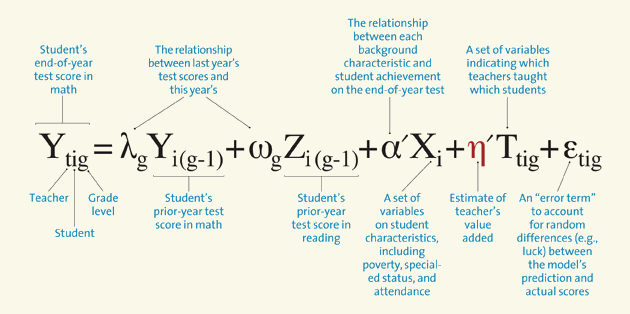
“Last year, I became really interested in African American history and their struggles,” she explained, clicking through presentation files on Ida B. Wells, Frederick Douglass, Ella Baker, and W.E.B. Du Bois. “Learning about this motivates me not to give up.” She opened a “Reconstruction Defeated” paper from the previous year. “I wanted to find out how did government justify treating African Americans unfairly with Jim Crow even though the Constitution said that all men and women were equal,” she told me. “Through this paper, I became really interested in the 14th and 15th Amendment.”
As I handed the memory card back to her, Maria said that as a sophomore she’d been determined to go back to her middle school to find the woman who’d told her that she’d never go to college. With her senior year under way, there was simply no time for that. She’d soon be filling out college applications and had recently been elected Latino student club president. She helped new immigrants at school. She also volunteered at a senior housing project through the Latino club, helping older neighbors. “And in my free time, I babysit my little cousins,” she told me. “From now on, I only have time to talk with you over lunch at school.”
ONE DAY THIS PAST SPRING AS I lingered in Roth’s room after class, a young teacher rushed in. “Robert, I’ve been teaching for years, but I’m really struggling this semester.” Her students’ grades were not showing any progress, she said, and they seemed to be losing interest. As the two looked over her grading book together, they realized she was attaching most of the grade to homework assignments and wasn’t giving significant points on the work students did in her class. Those assignments showed that they were learning, but since her struggling students only saw the Fs on their homework, their engagement was dropping.
Roth’s colleague, Pirette McKamey, has been teaching English and history for 24 years and is now the instructional reform facilitator at Mission High. She calls this kind of one-on-one mentoring “mucking in the dirt.” “Every day, there are hundreds of small intellectual conversations all over the school about student work,” explains McKamey. Along with Roth, she also co-leads a committee focused on improving achievement for kids of color, in which faculty review student work and grading policies and read the latest research. “What did the kid write? What did the kid produce?” McKamey says. “That’s all that should matter.”
An ample body of research shows that this kind of mentoring and peer review helps teachers figure out ways for struggling students to improve. But it doesn’t show up in standardized tests—and for many, it’s pushed aside by the constant battle to ratchet up scores.
Before NCLB there was a movement in many states, including California, to come up with reliable, unified rubrics for using classroom work to measure achievement—to move toward a mix of standardized tests and teacher assessments, something shared by most of the world’s top-performing school systems, from Finland to Hong Kong. But that effort got largely steamrolled by NCLB’s focus on high-stakes testing.
“I’m a history teacher,” Roth says. “I believe in systemic change and macro-level conversations. But when it comes to schools, what most people don’t realize is that it’s about work at the micro level. The biggest reform at schools lives at the micro level, and it has to do with improving the craft of teaching.”
There are some signs of a shift at the macro level. In 2009, President Obama asked states to “develop standards and assessments that don’t simply measure whether students can fill in a bubble on a test, but whether they possess 21st-century skills like problem-solving and critical thinking and entrepreneurship and creativity.” The federal government has allocated $330 million for developing tests for a new set of standards, known as Common Core, that will hit classrooms in 2015. Supporters say that while the new tests will still include multiple-choice questions, they will also offer some opportunities for writing, and the lists of standards will be shorter, leaving teachers more freedom.
But many education experts are skeptical. A recent Brookings Institution study finds no correlation at all between the testing standards and student achievement. Even Common Core advocates such as Ramanathan concede that there’s a disconnect. “California has long been considered to have some of the best standards in the nation,” he says, “but we also have some of the worst student outcomes.”
Roth, who has been coaching fellow teachers for two decades, told me that standards can act as a “political security blanket” and a general guideline, but they can’t help teachers with the more important tasks: figuring out how to apply the material in the classroom and gathering evidence to measure real understanding. Roth’s filing cabinets are filled with different lesson plans. But every year, he creates another folder for each class, and approximately 50 percent of the material is new. He then adjusts everything throughout the year based on what works with his students.
I observed the same in other successful classrooms at Mission. “I adjust my lessons and tests every day,” says a popular young math teacher named Taica Hsu. “The student body changes every semester, and what worked last year most likely won’t work next year.”
The Obama administration has softened some of NCLB’s impact, granting waivers to more than half of the states from the law’s most punitive section, which calls for all students to score “proficient” in math and English by 2014. But even in the waiver states, standardized tests remain the dominant measure for schools.
MIDWAY THROUGH MARIA’S SENIOR year in 2012, she was watching Waiting for “Superman” in Mr. Velez’s college expository writing class. They were learning about achievement gaps, test scores, teacher unions, charter schools, and different solutions offered to “fix” schools like Mission. In one scene, DC’s Michelle Rhee was shown firing the principal of a low-scoring school, and then the film cut to scenes of teachers and parents protesting school closures.
“Which facts in the movie shocked you?” Velez probed as the movie ended.
“What we spend on prison inmates,” one student called out.
“Why is it so hard to fire a bad teacher?” said another, visibly upset.
“I was shocked how low test scores are in California and DC,” added a student with big headphones around his neck.
“California test scores are low, but the movie didn’t mention we have the most immigrants here,” countered a classmate. “Our English scores are bad, but that doesn’t mean our school is bad.”
“What would you do to fix schools?” Velez asked. Students took turns calling out responses as Velez wrote down their suggestions on a whiteboard: Make the tests more meaningful…Allow our teachers to write these tests…Don’t test immigrant students in the first two years…Give more money to public schools in California…Make it easier to fire bad teachers…Ask students which schools are good and bad…
“Will they close Mission like those schools in DC?” Maria asked.
The shouting stopped.
“We won’t let them,” another kid responded, and the class burst out laughing. Velez kept writing.


